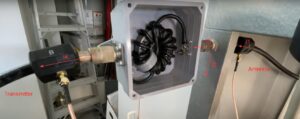NE6F’s common mode current tester – Part 1 ended with the following:
Common mode current adjacent to a small choke
Consider a straight section of coaxial feedline not close to other materials, and with a small common mode choke inserted in the feedline. A “small” choke means one that is a very tiny fraction of a wavelength, say λ/100, from connector to connector.
Q1: Ask yourself that if say 1A of common mode current flows into one connector, what is the common mode current at the other connector?
Q2:What is your answer if you were told the balun was specified to have a CMRR of 20dB?
The answer to Q2 is relatively easy, CMRR is not a meaningful statistic for a common mode choke deployed in a typical antenna system, it would not change the answer to Q1.
The answer to Q1 needs a longer explanation… let’s do it!
Common mode current distribution is almost always a standing wave.
Above is a plot of current distribution of an example dipole antenna system with coax feed. The dipole is slightly off centre fed to drive a significant common mode current on the vertical coax feed which is grounded at the lower end.
Note the standing wave on the vertical section, it has maxima and minima (if it is long enough), and these are unrelated to possible standing waves inside the coax, ie in differential mode.
Note that if we took spot measurements of the magnitude of common mode current |Icm| at points A, B and C we would get different results.
Broadly, Icm changes relatively slowly over a small electrical distance (say λ/100), except near deep minima if they exist.
Above is the same model with a common mode choke inserted near ground. Note that it has changed the magnitude and distribution of Icm, and more importantly, note that |Icm| at both ends of the choke are very similar, and in fact slightly lower on the antenna side of the choke.
If you make spot measurements either side of an electrically short (say length<λ/100), you will not usually find a large difference… except in the region of a current minimum.
The common notion that |Icm| is much lower on the tx / ground side of the choke is deeply flawed, and even worse is to think that CMRR can be used to calculate the reduction.
NE6F’s video of measurement of his balun’s effectiveness.
N6EF demonstrates measurement with his dual probe meter asserting that “this choke is doing a pretty good job,” but is the measurement a valid basis for that assertion?
Above is a capture from the video with my added notations of four currents, I1-4.
Having set his instrument to read 100% of scale on the Port A probe, he switches to display the Port B probe.
Above. a stunning drop, it is reading perhaps <1% of scale on Port B. Some might infer that proves CMRR>40dB.
Let’s look at that test setup again.
Above is a capture from the video with my added notations of four currents, I1-4.
NE6F demonstrates that I4 is less than 1% of I1 (though the meter response may not be linear at low readings).
Now look at the conductive bulkhead and the bulkhead adapter which connects the coax shield to the bulkhead. At this point a circuit node with three conductors is formed and currents annotated:
- I1: shield from the antenna side;
- I2: bulkhead conductor; and
- I3: shield to the choke.
The measurement made ignores the presence of current path I2, and so all conclusions are invalid.
With the information given earlier, you might well think that it is likely that I3 is approximately the same as I4 (measured at <1% of I1), and that I2 is probably almost the same as I1, ie that this shunts, diverts common mode current on the antenna feed line to ground. That might be an effective measure in preventing ingress to the equipment cluster, but it does not reduce Icm on the main feedline or the undesirable effects of that.
Of course that is just supposition… but it should drive measurement of |I3| to better infer |I2|.
Homework
Make or buy an effective common mode current meter, and make some measurements adjacent to a common mode choke to test your understanding of what it does or does not do.




